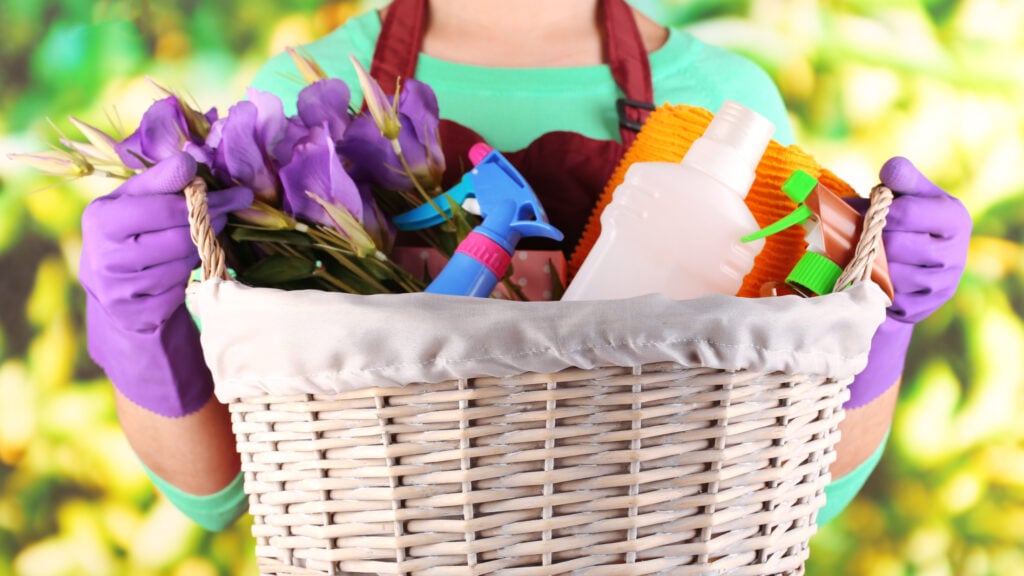
Why do we spring clean?
Sarah Harley
Roller blinds in need of a refresh? We share some expert top tips to help you get a sparklingly clean finish.
When it comes to window dressings, roller blinds are one of the most versatile options around. They’re usually made of harder-wearing fabrics such as polyester, PVC or vinyl, and can provide a neat and simple solution to providing privacy and regulating natural light in a room.
When it comes to window dressings, roller blinds are one of the most versatile options around. They’re usually made of harder-wearing fabrics such as polyester, PVC or vinyl, and can provide a neat and simple solution to providing privacy and regulating natural light in a room.
 Credit: Hillarys
Credit: HillarysBut, like everything else in your home, they need to be kept dirt free. If you raise and lower them every day, the last thing you want is for them to waft extra dust particles in the air – particularly during sunnier days, which can shine a spotlight on just how clean, or dirty, your home is.
Unfortunately, a blind can’t simply be taken down and chucked in the washing machine. In fact, it’s often better to clean it in situ. And that’s where our guide to how to clean a roller blind comes in.
Whether you’re planning a deeper spring clean or about to tackle your regular cleaning schedule, we’ve rounded up the top six steps for keeping your roller blinds spick and span.
“Roller blinds are one of the easiest window dressings to clean,” says Emily Booth, in-house advice expert at Hillarys. “For everyday cleaning, all you need to do is roll your blind down fully and use your vacuum’s small upholstery tool to gently remove any dust or dirt.”
Most upholstery tools have a fabric strip designed to catch lint and dust from blinds, sofas and so on. Simply pull down the blind to its full length and hold taut with one hand. Gently move the vacuum tool either across the blind (follow the grain of the material) or from top to bottom.
“You can also use a feather duster or a microfibre cloth if that’s all you have,” says Henry Patterson, cleaning expert at professional cleaning providers Housekeep.com, adding: “Don’t forget to dust around the blind fixtures too.”
If you prefer to regularly dry dust rather than vacuum your blinds, Blinds2go recommends that you don’t use a traditional yellow duster as these tend to leave fluff on the fabric. Instead, try a microfibre duster with an extendable pole that makes it easier to reach the top of the blind. Buy a pack of 3 on Amazon for £7.99.
 Credit: Amazon
Credit: AmazonOnce you’ve vacuumed or dry dusted your blind, wipe down with a clean, damp cloth. Advice on the type of detergent to use varies.
The Cleaning Collective’s suggestion is to use a little washing-up liquid mixed with lukewarm water.
Other suggestions we’ve found include using solutions of water mixed with either white vinegar, laundry detergent or bicarbonate of soda. We’ve even seen biodegradable baby wipes suggested as they contain very mild cleansers.
We recommend using Stardrops White Vinegar Spray, £1 for 750ml at The Range. We tested it on our own blinds and they came up a treat.
Always check the care instructions for your blind before using any cleaning products and where possible, test on an inconspicuous area before applying to the whole surface.
 Credit: Shutterstock/Andrey Cherkasov
Credit: Shutterstock/Andrey CherkasovWhen it comes to the mechanical winder, don’t forget to regularly spray it with silicone spray to prevent it sticking. But remember to protect the fabric when spraying as the silicone may leave marks.
If the winder and chain are made of plastic, a soapy water solution will help to remove any dirt. If they are steel based, then clean them regularly with a soft dry cloth – this will stop any water or condensation from forming on the surface, causing rust.
If you do use water to clean your winder and chain, make sure the chain is thoroughly dried afterwards.
 Credit: Shutterstock/New Africa
Credit: Shutterstock/New AfricaTougher stains may require a little more elbow grease, but you should take care when tackling them.
“If the stain is being particularly stubborn and won’t come out, try using a fabric stain remover,” says Booth. “But be wary that the treated area may look significantly lighter than the rest of the blind.”
Patterson recommends mixing a drop or two of soap or detergent with warm water, and points out that technique is also important.
“Dip a clean microfibre into your cleaning solution,” he suggests, “[then] wring it out slightly so that it’s not dripping wet and gently dab the stain to lift it. Keep rinsing and wringing your cloth in the cleaning solution as you remove the stain.”
 Credit: Shutterstock/Foto Duets
Credit: Shutterstock/Foto DuetsExtra attention is needed if winter condensation has resulted in the formation of mould spores.
If you do have to remove mould, always remember to wear rubber gloves and open a window to allow for ventilation.
When it comes to tackling mould spots on your blinds, Booth suggests the following: “Mould can be difficult to clean. However, it is possible to remove with the right technique. Pick up some fabric remover formulated for killing mould spores and using a stiff brush, gently brush the product on the affected areas.”
Patterson also suggests using a brush such as a toothbrush for mould removal, along with a solution of soap and water.
For a milder approach and with sustainability in mind, consider using one of the multi-purpose products listed in our guide to cleaning with a conscience. Each product listed is free of chemicals and made from natural ingredients.
 Credit: Shutterstock/Oleksii Bilyk
Credit: Shutterstock/Oleksii BilykAlthough you may have seen fans of Mrs Hinch suggest that we can remove roller blinds and soak them in the bath, blind manufacturer English Blinds says this method should be treated with caution.
“Polyester roller blinds, which make up the majority of the UK roller blind population, can’t be washed in the bath – full stop,” it confirms on its blog.
Doing so has risks of colour run, fading, fabric shrinkage and water marks, the company states: “Washing polyester roller blinds in the bath – by means of showering them off, scrubbing them, soaking them, using hot water, and/or cleaning chemicals and washing powders – will almost certainly ruin them immediately.”
The final stage in the process is to ensure you allow plenty of time before rolling the blind back up.
Why? “To prevent bad smells or mould manifesting on your window covering,” says Booth. “Leaving your blind to air dry after cleaning can [also] help prevent further outbreaks.”
 Credit: Hillarys
Credit: HillarysRemoving your roller blind and assuming you can pop it in the washing machine is not a good idea. Although it may seem like a quick and easy cleaning trick, it’s likely you will end up with a blind that is creased, pleated or even torn.

Written by Sarah Harley she/her
Published:
Since first picking up a paintbrush and experiencing the joy of re-decorating her bedroom in a questionable red, white and grey scheme as a young teenager, Sarah Harley was hooked on the world of interior design. This obsession even led to a real life ‘Grand Designs’ project in 2005 when she donned a pink hard hat and appeared on TV screens, project managing the renovation and extension of a Grade II listed 17th century Folly in South Wales.
Throughout her career, Sarah has gained an array of experience in several different roles, ranging from copywriting, PR, events management and photography to interior design and home staging. With her two passions being the written word and the joys of a beautifully designed home, Sarah’s mission is to open the door on the world of interiors, inviting readers in to help them work their way through the vast choice of products, ideas and trends so that their own homes can reach their full potential.